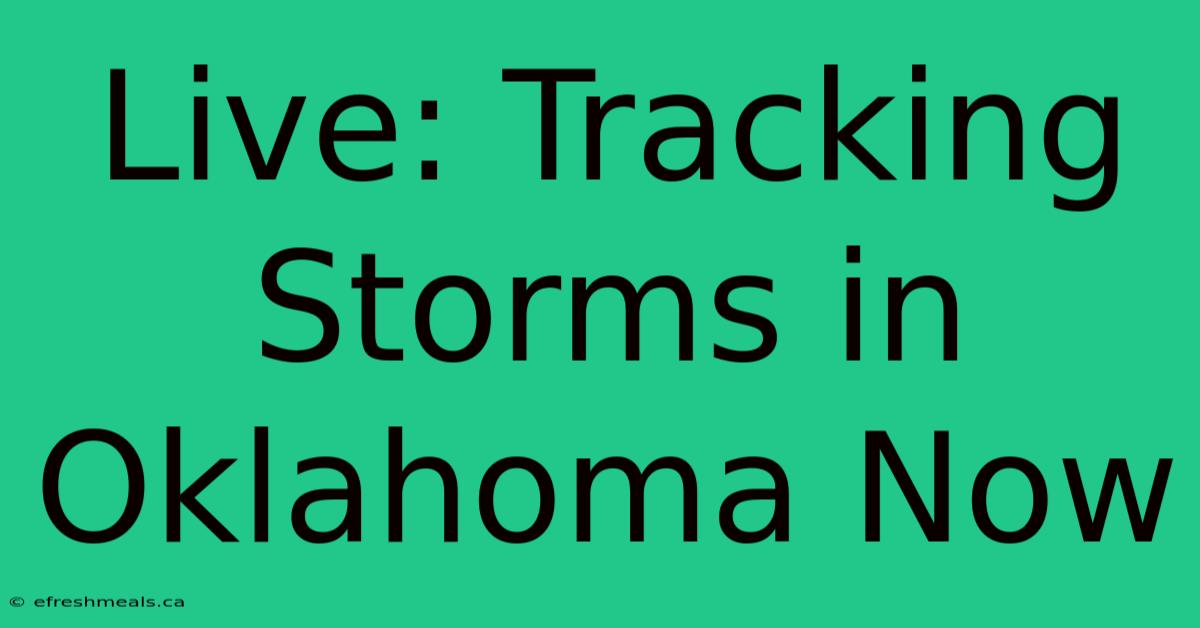Live: Tracking Storms In Oklahoma Now

Discover more detailed and exciting information on our website. Click the link below to start your adventure: Visit Best Website nimila.me. Don't miss out!
Table of Contents
Live: Tracking Storms in Oklahoma Now – A Powerful Tool for Safety and Awareness
Editor's Note: The Oklahoma sky is a fickle beast, known for unleashing powerful storms that can cause widespread damage. Thankfully, we have advanced technology that allows us to track these weather events in real-time, giving us precious time to prepare and stay safe.
Why It Matters: Understanding Oklahoma weather patterns is crucial for residents and visitors alike. The state is infamous for its unpredictable storms, ranging from tornadoes to severe thunderstorms and hailstorms. This live storm tracker serves as a vital resource for anyone in Oklahoma who wants to stay informed and make informed decisions during severe weather.
Key Takeaways of Live Storm Tracking:
| Feature | Benefit |
|---|---|
| Real-time Data | Up-to-the-minute information on storm location, strength, and direction |
| Visualizations | Interactive maps that clearly display storm movement and intensity |
| Alerts | Timely warnings and notifications for impending severe weather |
| History | Access to past storm data for better understanding of weather patterns |
Live: Tracking Storms in Oklahoma Now
The ability to track storms live is a game-changer for Oklahoma. It allows residents and emergency responders to see exactly where the storms are, how quickly they're moving, and what kind of threat they pose. This knowledge empowers people to take appropriate safety measures, from seeking shelter to securing their property.
Key Aspects of Live Storm Tracking:
- Radar Data: The heart of live storm tracking lies in radar data. Radar stations across the state send out radio waves that bounce off rain and hail, creating a detailed picture of storm activity.
- Doppler Technology: Doppler radar is especially valuable as it can detect the movement of rain and hail within a storm, helping forecasters predict the path and intensity of a storm.
- Satellite Imagery: Satellite imagery complements radar data, providing a wider view of the atmosphere, showing cloud formations and the overall weather patterns.
Radar Data:
Radar data forms the backbone of live storm tracking. It's crucial for understanding the current state of the storm, its potential path, and the intensity of its precipitation. Radar data is presented in various formats, such as:
- Base Reflectivity: This provides a general overview of precipitation intensity, showing areas of heavy rain or hail.
- Velocity Data: Velocity data reveals the speed and direction of precipitation, helping to identify rotation within a storm – a key indicator of potential tornado formation.
Doppler Technology:
Doppler radar goes beyond basic radar technology. It uses the Doppler effect to detect the speed and direction of precipitation particles. This allows meteorologists to identify areas of rotation within a storm, which can indicate the potential for a tornado.
Satellite Imagery:
While radar data provides detailed information about local storms, satellite imagery gives a broader perspective. Satellites capture images of the entire atmosphere, revealing cloud formations, storm systems, and overall weather patterns. This information helps meteorologists assess the larger weather context and predict the potential for severe weather events.
FAQ:
Q: Where can I find the live storm tracker?
A: There are several reliable sources for live storm tracking in Oklahoma. Your local news station's website is a great place to start. Also, the National Weather Service (NWS) provides free access to their live radar data and forecasts.
Q: What should I do if a severe weather warning is issued?
A: Seek immediate shelter in a sturdy building. Avoid windows, and be prepared to stay in place for an extended period. If you are in a mobile home, seek shelter in a nearby sturdy building. Follow the instructions of local authorities and emergency responders.
Q: How can I stay informed about severe weather?
**A: ** Sign up for weather alerts from your local NWS office. Download a weather app that provides real-time updates and warnings. Pay attention to local news broadcasts and weather reports.
Tips for Staying Safe During Storms:
- Know your area's history: Understand the types of storms your region is prone to.
- Have a plan: Decide where you will seek shelter in your home.
- Keep a weather radio: A weather radio can provide crucial warnings and updates.
- Stay informed: Follow weather reports and alerts from trusted sources.
- Be prepared: Stock up on emergency supplies like water, batteries, and non-perishable food.
Summary of Live Storm Tracking in Oklahoma:
Live storm tracking is a powerful tool that provides invaluable insights into weather patterns. It empowers residents and emergency responders to stay informed, make informed decisions, and ultimately stay safe during severe weather events. By utilizing this technology and staying aware of weather updates, we can navigate Oklahoma's unpredictable storms with increased confidence and preparedness.
Closing Message: The Oklahoma sky may be unpredictable, but with the right tools and awareness, we can weather any storm. Embrace the power of live storm tracking and stay safe throughout the year. Remember, preparedness is key to navigating Oklahoma's dynamic weather.

Thank you for visiting our website wich cover about Live: Tracking Storms In Oklahoma Now . We hope the information provided has been useful to you. Feel free to contact us if you have any questions or need further assistance. See you next time and dont miss to bookmark.
Featured Posts
-
Unique Halloween Costumes I Hate Gay Halloween
Nov 01, 2024
-
Shohei Ohtani World Series Journey
Nov 01, 2024
-
Eastbound Hwy 401 Closed In Cambridge
Nov 01, 2024
-
Fatal 401 Crash Wheel Detachment Near Cambridge
Nov 01, 2024
-
Sources Lakers Pass On Hood Schifinos Option
Nov 01, 2024
